|
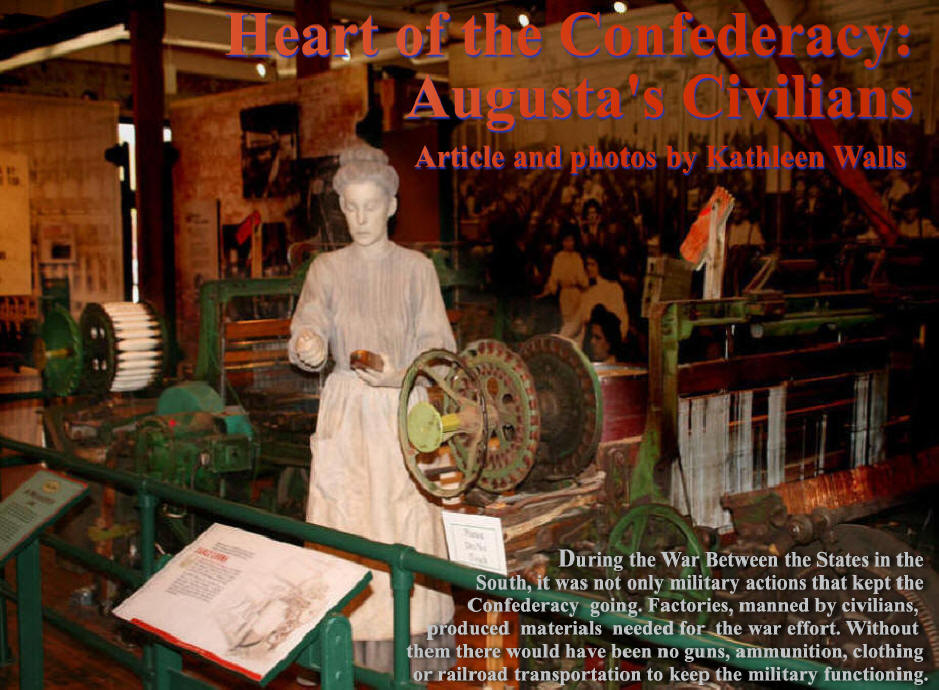
As it was, the South was far behind the North in this area. The
South was basically agricultural while the North was industrial.
One southern city that was far in advance of the majority of
other cities in the Confederacy in the industrialization
department was Augusta, Georgia. Here the civilians were the
real war heroes.
 |
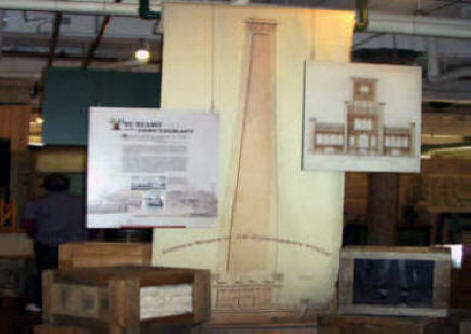 |
| The Confederate Obelisk seen
from Augusta Canal |
Power Works Exhibit at Augusta Canal
Interpretive Center |
In July 1861. Colonel George W. Rains,
directed by Confederate President Jefferson Davis,
selected Augusta as the site of a massive powder works
factory. The Augusta
Powder Works, a two-mile-long compound of Gothic revival
buildings bordering the Augusta Canal, was constructed in just eight
months. It was the only permanent facility ever constructed by
the Confederate government.
The Augusta Powder Factory was the second largest in the world
in its time. It was
capable of producing as much as 7,000 pounds of gunpowder per
day, and by the end of the war, more than 3 million pounds had
been produced. The human element that went into this massive
effort was mainly women, children and African American slaves.
In fact African Americans provided about half of the workforce
of the factory. Without these civilians, the war engine would
have been stopped before it got started.
All
that remains of the Powder Factory is
the smokestack, a 168
foot tall obelisk, which
was left standing as a memorial to citizens the Confederate
dead. Today the best way to understand that part of Augusta's
history is by taking a Petersburg Boat tour. They are currently
offering a Civil War
Sesquicentennial tour "Food, Fabric and Firepower." The
tour has a knowledgeable captain and a tour guide that explains
what you see along the canal's banks and what was once there.
It's a pleasant ride and you are sure to spot some wildlife
along the way.
 |
| One of the Petersburg Boats |
Powder without guns and ammunition is
useless. The foundry in Augusta was originally a U.S. Arsenal.
The building of the arsenal began in 1816 on the advice of
George Washington. It was originally on the banks of the Savanna
River but due to the low lying swampy
land, the site proved unhealthy.
In 1826 and 1827, it was moved by wagon and reassembled
exactly in its original layout farther uphill on the site of
present day Augusta State University recently renamed Georgia
Regents University, The present quadrangle buildings were part
of the original arsenal. Rains Hall, home of the second in
command, Benet House, the original commanders home, Payne Hall,
the original headquarters building and Fanning Hall, once the
barracks for enlisted men and bachelor officers. Later in the
war, Fanning Hall
was used as a hospital. One
of the more famous inhabitants who would have stayed at Fanning
Hall was a young
lieutenant, William T. Sherman, who was stationed at the arsenal
for about six months in 1844. The brick wall around the
quadrangle still has firing holes from its
arsenal incarnation. When Georgia Succeeded, it took
over the arsenal. Although manned and managed
by military personnel, the arsenal employed civilians.
Women workers at the arsenal made cartridges for a dollar
a day.
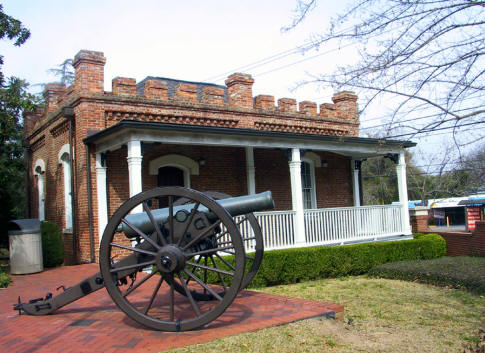 |
| Arsenal Guardhouse |
Aside from the quadrangle there is
another interesting building from that period along the Campus
History Walk. On the corner of Walton Way and Katherine Street
you can visit a restored
1866 Arsenal Guardhouse. It now serves as a History Museum
housing artifacts, photographs, and other memorabilia of the
period. Many of the artifacts were excavated in archaeological
digs on campus. What was once a cell is now refinished with
figures in period costume, portraying life in the guardhouse in
the late 1800s.
In front of the museum is a cannon. It
was one of Semmes Artillery pieces not manufactured at the
foundry but surrendered there at the end of the war.
Just a little farther down the Walton Way
and Arsenal Street History Walk you will find a military
cemetery that holds the remains of U. S. and Confederate
soldiers and their dependents.
Clothing manufacture and the production
of cloth were another necessity for the military that was
staffed by civilians, mainly women. A Confederate Naval Supply
shop made shoes and uniforms for navy personnel. Confederate
Quartermaster's Office, Confederate Clothing Bureau, Georgia
Clothing Bureau and Augusta Factory, which made clothe for the
army, all hired huge amounts of civilian labor again mostly
women.
 |
| Civilian
Worker Exhibit at Augusta Canal Interpretive Center |
Augusta ladies began forming groups to
help the war effort. The Ladies Volunteer Association of
Richmond County and the Ladies Volunteer Sewing Society made
uniforms. Ladies Lunch Association fed the troops at the depots
as they passed through Augusta on the trains. The Ladies
Hospital Relief and Hospital Association started a Wayside Home
for wounded soldiers. There was even a Ladies Gunboat
Association to build a gun boat to protect them form attack by
way of the river. for the first time, women in the south took on
rolls previously designated "masculine."
The Augusta Canal Interpretive Center,
also the place to board the Petersburg Boat tours, offers a
wonderful view of the history not only of the Augusta Canal but
of the mills and factories. There is a section showing the
"Wartime Industry-serving the Confederacy" in the "Mill
and Boom Times Exhibit." It is one museum you want to be sure to
visit.
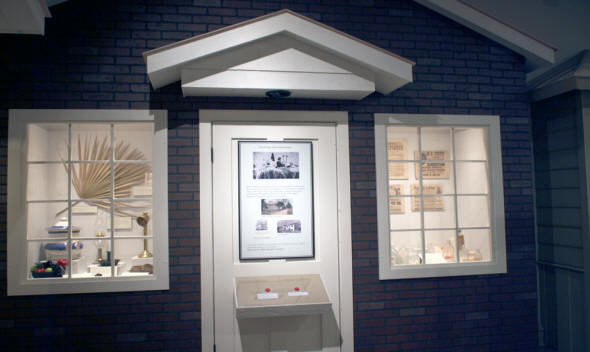 |
| Augusta Museum of History's
Augusta 1864 Exhibit |
Another museum which will expand your
knowledge as well as entertain you is the Augusta Museum of
History. Currently there is a temporary exhibit dealing with
Augusta during Sherman's March to the Sea called "Augusta,
1864." Today, we
know Sherman bypassed Augusta but the people living thorough
that terrible war had no way of knowing how history would play
out. It was commonly believed that Sherman would swing over to
Augusta after Savanna. This exhibit provides an intimate look at
the citizens of Augusta during that critical year. There are
voice casts where you press a button and hear the thoughts of
citizens of Augusts, the highborn, lowborn, free and slave.
A sample store, items from everyday life, spectacles,
shoes, clothing make this exhibit a trip back in time.
The other exhibits in the museum are well
worth seeing as well so allow yourself a few hours to visit it.
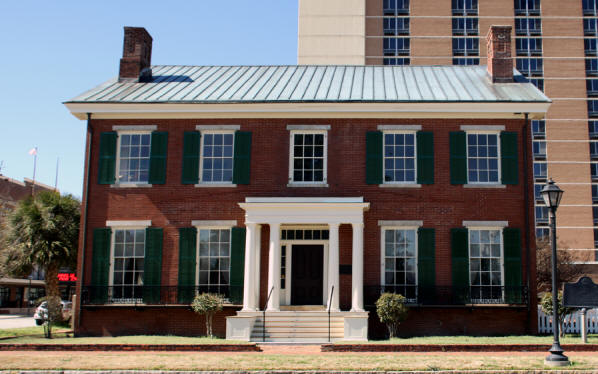 |
| Woodrow Wilson's Home |
There were other Augusta civilians who
were touched by the
war. One place where the war intersected with a young boy who
would later find his place in history and have to deal with
another devastating war., was the First Presbyterian Church of
Augusta at 642 Telfair Street. The church is worth a visit for
its beauty as well as its history. The single spired Romanesque
church was completed in 1804 and designed by architect Robert
Mills, the architect who designed the Washington Monument. It is
on the National Historic Register.
The pastor of the church during the time
of the War Between the States was Joseph R. Wilson. He was a
firm secessionist. He and his family lived in the Manse just
across the street. His youngest child
was a boy called Tommy. Tommy was about three or four
when his first memory of the war occurred. He was playing near
his front gate when he heard two men passing by discussing the
election of Abraham Lincoln. "This means war!" one man declared.
During the war the church was used as a
hospital for soldiers wounded at the Battle of Chickamauga.
After the war's end he saw captured Confederate president,
Jefferson Davis, brought through the streets of Augusta under
guard on his way to prison at Fort Monroe.
Imagine how this
influenced the life of future 28th president, Thomas Woodrow
Wilson. His Boyhood Home is open for tours.
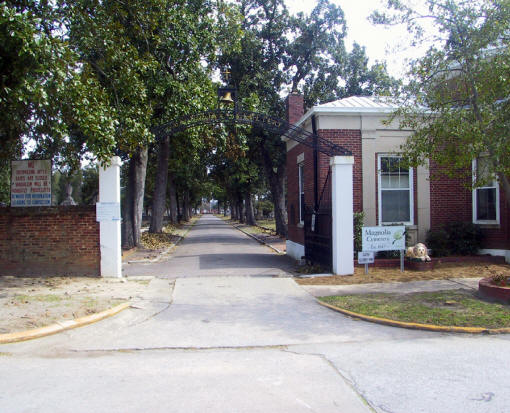 |
| Entrance to Magnolia Cemetery |
The soldiers who dies at the First
Presbyterian Church were buried at nearby Magnolia Cemetery as
are seven Confederate generals; Brig. Gen. Edward Porter
Alexander, Brig. Gen. Goode Bryan, Brig. Gen. Victory Jean
Baptiste Girardy, Brig. Gen. John King Jackson, Brig. Gen.
William Duncan Smith, Brig. Gen. Marcellas A. Stovall and Maj.
Gen. Ambrose Ranson Wright. When
you visit, you will note the cemetery's east facing brick wall
has loopholes knocked out of them. This was done so they could
be used to fire rifles through as part of the fortification when
it was believed Sherman was headed for Augusta. The cemetery's
earliest burial was in August 1818.
Some of the Antebellum residents of
August who were drastically effected by the Civil War was
its African American population. The one place where they
would have been able to meet and perhaps voice their thought
most truthfully was Springfield Baptist Church. The
church was originally built by Methodists. When they moved
the Springfield Congregation bought the building.
The congregation has roots dating back to 1787 and during
the war years had a congregation of over 1,000 members.
The old wooden church which is still used for meetings
and special events is the oldest independent black church on its
original site in the U.S. It was founded for free blacks, by
blacks. In 1866, the Georgia Equal Rights Association began at
this church as did Morehouse College in 1867.
Augusta's Confederate Monument is one of
oldest and, at 76 feet, the tallest in the state. It is made of
Italian Carrara Marble atop a stepped 22-feet square base of
Georgia granite.
Augusta native Private Berry Benson stand atop the monument.
Benson was an Augusta native Confederate scout who was
repeatedly captured and each time escaped. Around the base you
find the life-size
statues of Confederate Generals Robert E. Lee, Stonewall
Jackson, T.R.R. Cobb and W.H.T. Walker.
Yes, the monument honors the military
faction but remember for every slain Confederate soldier, there
were civilian relatives and friends affected by his death. The
inscription, later used on other Confederate monuments around
the South, recognized the sacrifice of the entire Confederate
nation, both soldier and civilian when it states, "No Nation
Rose so White and Fair: None Fell So Pure of Crime."
For more info:
http://www.augustaga.org/
https://www.augustacanal.com/Default.aspx?PageId=32
http://www.augustacanal.com/Default.aspx?PageId=18
http://www.augustamuseum.org/
http://www.wilsonboyhoodhome.org/
http://www.cr.nps.gov/nr/travel/Augusta/springfieldbaptists.html
http://www.augustaga.org/Things-to-Do/Civil-War/Confederate-Monument2
|
![]() Ads fund American Roads so please consider them for your needed
purchases.
If you enjoy the articles we offer, donations
are always welcome.
Ads fund American Roads so please consider them for your needed
purchases.
If you enjoy the articles we offer, donations
are always welcome.
|